What Is A Columbarium?
The columbarium is a building or part of a church, cemetery, or other dedicated space that houses urns. The term comes from the Latin word for ‘dovecote’ and refers to the niches in which ashes are stored.
Columbaria are often thought of as mausoleums designed expressly for cremated remains and their accompanying containers.
Columbaria can be freestanding or part of a structure, such as a church. They can also be outside in the elements or within a building or covered structure.
Columbaria are usually used as an alternative to traditional burials, and many cemeteries now include columbaria as part of their grounds. Columbaria offer families and friends a place to remember and visit loved ones who have passed away.
Whereas ashes can also be scattered in a designated place or buried in a traditional cemetery plot, these centers of remembrance are different. Columbaria provide a permanent sense of peace and comfort for those who mourn the loss of a loved one.
What Is A Columbarium Niche?
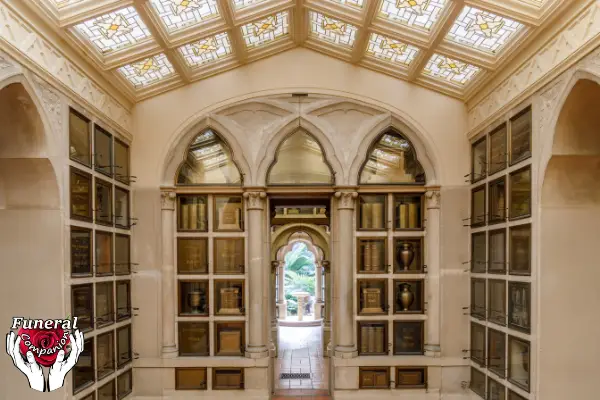
A columbarium niche is an ornamental recess or alcove in a wall, usually of marble, for the inurnment of urns. These are already commonplace in many places around the world and are gaining popularity, along with cremation, in the USA.
The niches can be rented for a term of years (say a decade), at a certain yearly price. This means that families have the ability to move a loved one if they themselves need to relocate. This would be nearly impossible with a traditional interment.
The ashes of the deceased are placed in an urn, which is then deposited in the niche. Depending on the style of the columbarium niche, the urn may be placed behind a marker, slab, or even sometimes (though less common) buried below the floor within the niche. In either case a slab of marble, with an inscription, is placed over it.
Although in the USA columbaria are not as common as in, say Europe, you will still be able to find one in most counties. There is also the option if you wish to inurn someone on private land, of purchasing your own Columbarium.
If you want to find one, just do an online search for “columbarium” and the name of your city or town.
History Of The Columbarium
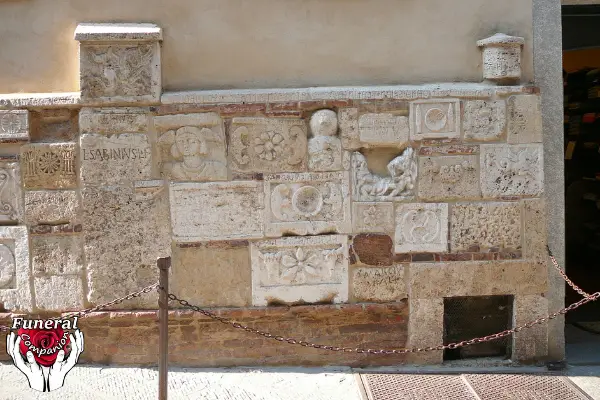
The history of the columbarium goes back to ancient Rome, where they were first used to store the ashes of cremated remains. The word “Columbarium” apparently derives from the word for ‘dove’ or ‘pigeon’ and refers to the small rooftop coops these birds were held in.
When the Romans buried the ashes of their dead held in urns, they did so in niches in the ground. Perhaps the shape of these reminded them of the birdhouses and the word stuck.
Somewhere between the 2nd and 3rd centuries, the practice of cremation and the use of Columbaria fell out of favor. Romans began burying their dead instead, possibly because of the rise of Christianity after Emperor Constantin converted on his deathbed, and thus converted the entire empire.
As a result, Columbaria became less popular in Europe in the run-up to the Middle Ages, and these niches, especially in Italy, were often used for other uses by contemporary people.
In the meantime, Columbaria had been adopted by many cultures in Asia, especially those which were Buddhist. Cremation is usually the practice in these cultures and Columbaria remain popular even to this day.
Columbaria began to gain popularity in North America in the early 20th century, and they are now becoming a common feature of cemeteries all over the world.
How Does A Columbarium Work?

In very basic terms the way that a columbarium is used is as follows:
The remains of a cremated person are placed in an urn which is then placed into a space in the columbarium. In some cases, particularly if there is more than one person being buried in the columbarium, the ashes of more than one person can be placed into a single urn, although this is really a drastic option. Companion niches are quite common and will accommodate at least two urns. The urn is then sealed and the space marked with the name of the deceased or a reference number that is associated with their name.
There are different styles of the columbarium, from a simple wall with niches behind to glass-fronted ones. This allows the urn to be visible as well as any mementos the family has included in the niche.
The columbarium building can be centralized in which case it is a part of a larger cemetery property or it can be a free-standing one not associated with a burial ground. These structures can be under the elements or in a covered area and even inside a dedicated building.
The Columbaria can also be found in different shapes and sizes, including round, square, and even octagonal.
Columbarium Niche Dimensions
With burial space becoming more and more valuable, many columbaria are designed for the maximum capacity. The standard-sized single columbarium niche is usually 9 inches by 9 inches. This gives adequate space for a standard size urn, and also the most efficient use of space.
| Columbarium Niche Type | Width | Length | Depth | Average Cost |
|---|---|---|---|---|
| SINGLE | 7.5 – 8 ½” | 10.5 – 12” | 12” | $2000 -$2100 |
| DOUBLE | 10.5 – 12” | 10.5 – 12”h | 12” | $2500 – $3,100 |
| TRIPLE | 12.5 – 18 ½” | 12 – 12.5” | 12” | $3000 – $4100 |
However, this is just a guide. The design and size of a niche can vary depending on location, whether the Columbarium niche is indoors or outdoors and the number of urns it’s intended for. So it’s important to check with the cemetery before purchasing an urn.
Advantages & Disadvantages Of Columbarium Niches
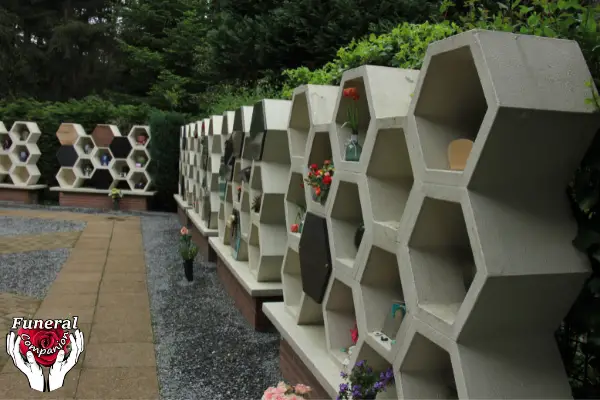
With the move towards cremation and the increased use of columbarium Niches across the USA, there are certainly many benefits to their use. That being said, there are also several drawbacks which need to be considered too. So, let’s discuss them below.
Advantages of Columbarium Niches
A dedicated focus for remembrance
When a person dies, their loved ones may feel the need to visit a place where they can remember them. A Columbarium provides that space and can be a comforting reminder that the deceased is still remembered and loved.
Although a grave can provide a similar sense of comfort, they aren’t always pleasant to visit in all weather conditions and require a lot more upkeep to keep them looking serene.
A fast track burial option
Using a Columbarium can be a quicker option than a traditional funeral for several reasons. As cremation can be performed within days, there is no need for a body to be embalmed (especially if you forgo a visitation) and there is no need for a burial plot which incurs opening and closing fees.
This can provide the grieving with swift closure or comfort much more quickly than a traditional funeral.
All-weather burial shrine
One of the benefits of an indoor or covered columbarium is that it allows visitation in any weather condition. This is important because it ensures that family and friends can still pay their respects to their loved ones, even if it’s raining or snowing outside.
More affordable burial option
There are many reasons why a columbarium is cheaper than the burial of ashes or a body. For one, the columbarium takes up less space than a traditional burial, and there is no need for a headstone or other marker. In addition, columbaria, are often located on church grounds or other public areas, which means that there is no need to purchase land for a burial plot. Finally, the cost of maintaining a columbarium is typically lower than the cost of maintaining a traditional burial plot in a cemetery.
Stress-free burial option
As I’ve referred to before, a niche in a columbarium is going to be much cheaper than many of the other options available for burial. When looking just at the burial of ashes, you will save yourself a few hundred to a few thousand dollars on the purchase and erection of a headstone.
In terms of ease, a niche in your common columbarium is just waiting for you to use it. Unlike a burial plot, you don’t need to wait while a purchase goes through and the grave is dug for use. You are able to transfer the ashes directly to the cemetery to be inurned in the columbarium.
Less environmental impact
Burial plots use up valuable land and resources, whereas columbaria can house many urns in a small space. This has a much smaller impact on the land and means that less is needed to bury our growing populations.
Uses fewer resources
Despite the fact that they may be built of inorganic materials, there is a lot less concrete that goes into the building of a columbarium than the vaulted structures of graves. Unfortunately, this material is also a big producer of CO2 emissions.
Fewer chemicals involved
Also, when traditional burial takes place, embalming fluid and other toxic chemicals are often used that can contaminate groundwater. columbaria do not require any such chemicals (especially for direct cremation), making them more environmentally friendly.
Reduces the need to rush burials
Generally, when you are expecting a delay in the actual burying of your loved one, cremation in itself is more advantageous. When the body has been cremated, you can store the ashes in an urn for a long time.
This means that if you need to delay a funeral service for several weeks, you easily do it. The advantage that columbaria have is that you could quickly put together a funeral service or inurnment at short notice as there isn’t much to be done when at the actual cemetery.
Short term leases are available
I see this as a great advantage for modern Americans who can easily be relocated across the country for work or other reasons. Knowing that you aren’t locked into a permanent resting place for your loved one means that you can bring them with you if you need to move.
So the fact that these niches can be leased for a number of years, if needed, rather than forever is a great advantage.
Disadvantages of Columbarium Niches
As good an option columbaria are for some, they will not be a fantastic fit for every family and so we should also talk about some of their negative aspects too.
Cremation is not condoned in some religions
Despite cremation now being central for over 50% of all funerals in the US, there are still some religions that don’t allow it. Islam is one as are some sects of Christianity.
If you want to know more about what the bible says about cremation, please read my article here.
Not the most affordable method
Frankly, cremation is a bargain in the face of rising burial costs. If you want to keep costs down further, then a columbarium may not be as cheap an option as scattering ashes or simply keeping them in your home.
Not a traditional burial method
It’s hard to change ingrained beliefs and practices. If you fear getting strange looks or comments from family, then going down a more traditional route may be better.
Sparks familial arguments
Unless your deceased loved one expressly asked to be inurned in a columbarium, you might find that even your family members disagree with burying their ashes in one. This can add stress to the funeral planning process and internal strife.
lack of individual grave marker or uniqueness
We all want to honor our dead, and sometimes the lack of a large headstone to do so seems wrong. Usually, only a small plaque is used to identify the person buried in the niche, which doesn’t always leave space for personal messages. Sometimes there is just a reference number with no name at all.
Cremation increases your carbon footprint
Despite the impact traditional inhumation burials have on the environment, there is no doubt that cremation produces a lot of CO2. Although steps are being taken to reduce this with newer methods of cremation, it’s by no means the most eco-friendly burial rite.
Overall, Columbarium Niches offer many benefits and are a unique form of burial. They can be affordable and customizable, and provide an enduring memorial. However, they do have some drawbacks, such as limited space and the need for annual maintenance.
Where Are Columbaria Located?
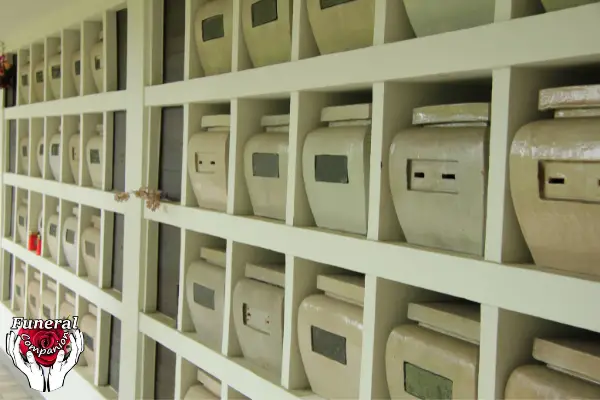
Columbaria or cremation niches can be found in several different types of locations from:
- Traditional public cemeteries
- On the grounds of a crematorium
- In a columbarium garden attached to a burial ground
- In a church crypt or within its niches
- In a Buddhist temple or purpose-built burial center
- Outdoor monuments, either on public or private land
You are most likely to find a Columbarium at a typical cemetery, but they can also be built as part of mausoleums, which are used to house casket burials, or as free-standing structures.
They can also be built as separate buildings with coverings or even several floors. It’s also possible to purchase a private columbarium to be placed on private land or within a cemetery
The size of a columbarium can range from five niches to more than 100,000 niches on multiple levels. Columbaria can be found in many countries around the world and are becoming more popular in the USA.
Types Of Columbarium Niches
Columbaria come in all sorts of designs and sizes, and the niches can vary too. Depending on your needs, you may wish to buy or purchase a different type of columbarium niche.
There are a couple of types of columbarium niches:
Single Niche: A single niche is a small, vertical opening in a columbarium wall that can accommodate one cremation urn.
Companion Niche: A companion niche is a larger, horizontal opening in a columbarium wall that can accommodate two cremation urns.
The price for these will vary from state to state and also by the design and materials used to build the columbarium.
There are also different materials used for columbarium niches:
Granite or Marble Front Niches:
Granite and marble are both durable, long-lasting materials that can be carved into a variety of shapes and designs. They are often used in columbarium design
Bronze Niches:
Bronze is a sturdy metal that can withstand the elements and will not corrode over time. This is why many columbaria incorporate this material into both slabs and plaques
Glass Front Niches:
Glass-front niches allow for natural light to enter the columbarium niche as well as the ability to display keepsakes or mementos for the visiting family to see.
Memorial Bench Niches
Memorial Bench Niches are a type of columbarium niche that is designed to hold cremation urns as well as a memorial plaque or marker. The memorial plaque can be inscribed with the deceased’s name, dates of birth and death, and a brief message. The bench is usually made of granite, marble, or bronze and can be placed in a variety of locations, such as a park, garden, or cemetery.
The cost of a memorial bench niche will vary depending on the materials used and the location where it is placed.
What Is The Difference Between A Mausoleum And A Columbarium?
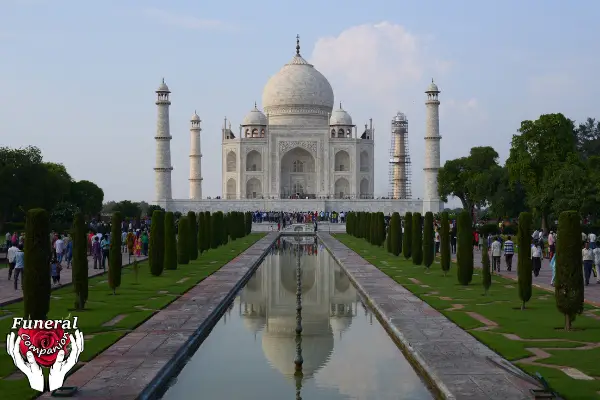
Mausoleum and Columbaria are often confused as they serve a very similar purpose.
A mausoleum is a type of building that is used to store the remains of a person or people placed in a casket. A columbarium is a type of building that is also used to store the remains of a person or people, but it is specifically designed to store urns with cremated remains.
It is possible for a columbarium to be part of a mausoleum structure, and so both inhumation and inurnment are possible. Usually, however, mausoleums are privately owned and most columbaria will only be used for inurned remains.
Affordable Alternatives To Columbaria
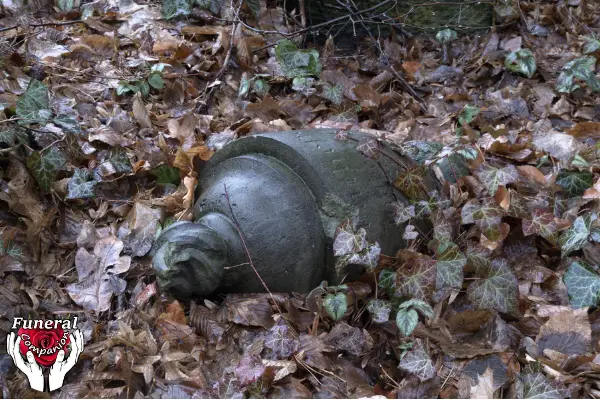
Opting for a columbarium can be the ideal option for many families, but when it isn’t possible due to location or budget, there are other ways to dispose of ashes in a respectful way.
Burial in a grave or memorial garden.
This is a great option if you already have a loved one buried in a cemetery. Often you have the right to bury at least one urn in a grave. Be sure to ask permission and work with the cemetery before doing this.
Alternatively, many cemeteries offer a dedicated area for these types of burials. It may be a cheaper option.
Another advantage of this type of inurnment is that you can then place a dedicated grave marker on the burial spot, which is something that you can personalize with an engraving.
Hold onto ashes or opt for a private burial
By far the most affordable method is to keep your loved one’s ashes with you at home. You can keep them on display on your mantelpiece, or with a little bit of effort, you can build your own columbarium niche in your backyard or on your private property.
Scattering ashes: land, sea or air
If you don’t want to keep your loved one at home or they requested to be scattered, then this is going to be free in most cases. There are many options for scattering ashes from parkland to the ocean. Always ask for permission to scatter ashes on public land and make sure you follow the EPA’s rules on doing so at sea.
Separate urns for family
The only problem with inurned ashes is that they are generally kept in one place. If you have a family which is spread across the country or globe, they may wish to keep a portion of your loved one’s ashes. This is something that a funeral home can do for you when transferring cremains to an urn.
Ashes As keepsakes
A popular trend is to turn ashes into a keepsake. This can be in the form of jewelry art or even a stuffed toy. It’s a fun way to remember the bed on a daily basis.
Bio-urns: reduce your carbon footprint
A lovely way to give your loved one an ecological legacy is to use their ashes in a bio-urn to grow a tree in your backyard or in a forest. This may not give you the same type of visiting experience as a columbarium, but it is something that can offset some of the carbon emissions released during their cremation.
Columbarium FAQS
Can Human And Pet Remains Be Placed In A Columbarium?
I am a pet owner, and I know just how much we love our furry friends. Many people want to be reunited with their pets when they pass away, so is that possible when opting for burial in a columbarium?
Inurnment of humans and pets in most columbaria is possible. However, this is not going to be the established policy for most cemeteries and may require some subterfuge on your part. It’s not an uncommon practice in the USA but depends on prior permission from the state and local organizations.
Basically, what they don’t know won’t hurt them. There is nothing stopping you from either buying a companion niche or including the two urns (Although you may find it hard to explain this in the paperwork).
Alternatively, you could combine the ashes of a pet with its master and just fail to inform the cemetery. Of course, you need to make sure you have a large enough urn for the job and one which will fit in the niche.
For more information on being buried with a pet in the USA, please read my full article here.
Is A Columbarium A Cemetery?
A columbarium is not in itself a cemetery as it does not cater to inhumation, the burial of bodies in caskets. In fact, columbaria are often a dedicated section of a burial ground catering to the burial of human ashes only. However, these structures can also be found in other locations, such as religious buildings.
What Is A Columbarium Inurnment?
A columbarium inurnment refers to the practice of enclosing human cremains, or cremated ashes, stored in an urn in a dedicated recess within a structure. This is usually done above ground and does not require an individual grave plot to do so.
How Much Does A Columbarium Cost?
The cost of a columbarium niche is really going to depend on where you live and the offering available at the time.
On average, a single columbarium niche could cost around $1,000 whereas a companion niche will be closer to $2,000. This being said, some churches will offer places for as little as $600 to parishioners while other locations will cost as much as $8,000 for premium eye-level locations. Buying your own freestanding columbarium can be as little as $4,000.
Clearly, you need to make some phone calls and shop around to get the most affordable option for your budget.
Conclusion: Why choose a columbarium?
Columbaria are fast becoming the norm in the USA when it comes to urn burial. They provide a clean and beautiful memorial to our loved ones which makes visiting their final resting places more pleasant.
As a budget option, columbaria have many advantages if you are able to negotiate a good price for the niche. It also provides families with a much easier way of being buried together without the need to plan ahead and purchase a large burial plot.
However, inurnment is not the only option for disposing of human ashes and still comes with a hefty price tag.



